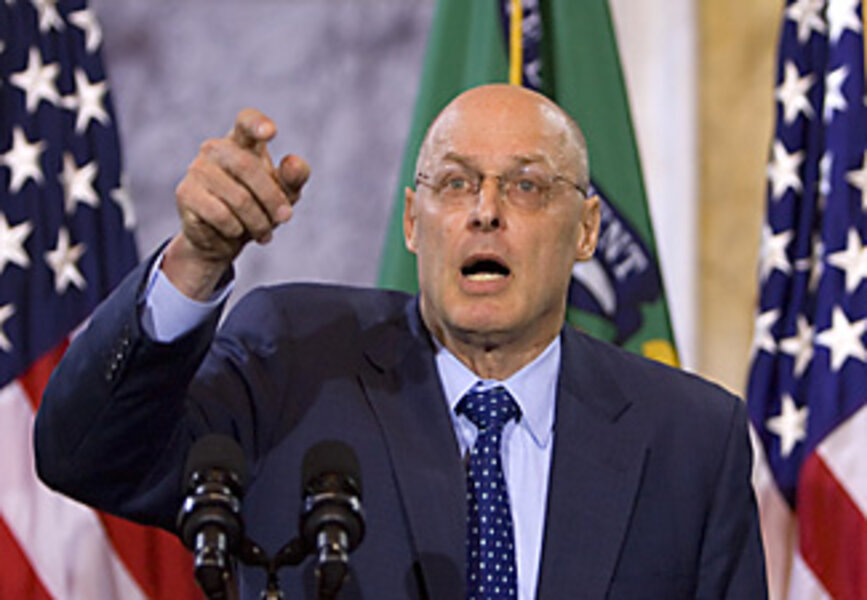Paulson proposes major new role for the Fed
Loading...
| New York
The Federal Reserve already manages the economy: setting interest rates, supervising banks, making sure the nation's payment systems operate efficiently. Now, the Bush administration is proposing that the Fed become a supercop for the nation's financial system.
But should the central bank be that powerful? Can an unelected group of overseers – whose record in dealing with the latest financial crisis looks mixed – also run the world's leading capital markets?
Those are two key questions already percolating in the halls of Congress – and beyond – in the wake of Treasury Secretary Henry Paulson's call for a sweeping reform of the financial system. The plan would represent the biggest overhaul since the Securities Act of 1934, a legislative reaction to the financial abuses that led to the Great Depression.
Under Mr. Paulson's proposal, the Fed would become a "market stability regulator," gathering information, collaborating with other regulators, and monitoring risk across the board. But the Paulson plan also envisions a "prudential regulator," which would focus on the safety and soundness of firms with federal guarantees. And the Fed would also be involved in a revamping of the mortgage origination business, perhaps as part of a new Mortgage Origination Commission, which will undertake a review of the entire home lending system.
"This is a complex subject deserving serious attention. Those who want to quickly label the blueprint as advocating more or less regulation are oversimplifying this critical and inevitable debate," said Paulson in his speech on Monday. "The blueprint is about structure and responsibility."
Once Congress focuses on the Paulson plan, it is likely to be a heated debate.
Some finance experts argue the Fed already has its hands full.
"A case could be made where the Fed just focuses on monetary policy," says Kenneth Thomas, a finance expert at the University of Pennsylvania's Wharton School. "Bernanke has his hands full."
He says the Fed also fell flat in recent years in its current regulatory role, raising questions about whether to extend new powers on that front. For example, banks shifted a lot of their risks off their balance sheets, thus negating the need to set up reserves against losses. "Where were they in terms of monitoring the level of off-balance-sheet risk" that banks were taking with complex investments? asks Mr. Thomas.
However, other finance experts believe the time is right for a major overhaul of a system that may be vastly out of touch with the markets. "The Fed has to have enough authority to know where the bombs are hidden," says Doug Roberts, a monetary expert at Channel Capital Group in Shrewsbury, N.J.
Mr. Roberts compares the effort to the Glass-Steagall Act, passed in 1933, which required the separation of banks and investment banks. Glass-Steagall was revoked in 1999. "We're now saying we need a Glass-Steagall Part II; we made a mistake," he says.
One of the compelling reasons for reform, says Lyle Gramley, a former Fed governor, is the potential for systemic risk – that is, a financial calamity that affects the nation's financial well-being. "We now know we have hedge funds, private equity groups, investment banks [and] we used to lean on market discipline to regulate them," says Mr. Gramley, a consulting economist at the Stanford Group in Washington. "It's not enough. We need some kind of overarching regulation."
However, some critics, particularly in Congress, maintain that the Paulson plan does not go far enough. Sen. Charles Schumer (D) of New York wants regulation of some of the complex new financial instruments devised by Wall Street. "The Treasury Department should address these issues as well," he said in a statement.
Bob Eisenbeis, a former executive vice president at the Atlanta Federal Reserve Bank, says he is disappointed in the Paulson proposal, too. "It's a reshuffling of responsibilities without any concern of underlying efficiency issues," he says.
Under the Paulson proposal, there would be three distinct regulators: the Fed, a new prudential regulator of institutions with federal guarantees, and a new business-conduct regulator, possibly a combination of the Securities and Exchange Commission and the Commodity Futures Trading Commission.
Mr. Eisenbeis says a restructuring is likely to run into resistance. "The regulators are opposed to giving up their power; the institutions have fought it in the past," he says.
Most observers doubt Congress will take up the most sweeping provisions this year. "This is like a birthing process and we are in Month 1," says Mr. Roberts.
Gramley thinks any regulation will have to balance Wall Street's competitive needs with the need for closer supervision. "Those who are going to be regulated will argue [that] if the capital requirements are more onerous than investment banks abroad, it will reduce their competitiveness," he says. "It will be a legitimate concern."
There is also a danger of stifling Wall Street's creativity. Many analysts blame the financial engineering of the 1990s for the current credit market crisis. However, Gramley points out that despite all the problems in the subprime mortgage market, the concept allowed some 5 million to 6 million people who would not have qualified to obtain a mortgage. "It's a definite social good," says Gramley.
•Staff writer Mark Trumbull contributed to this story.






